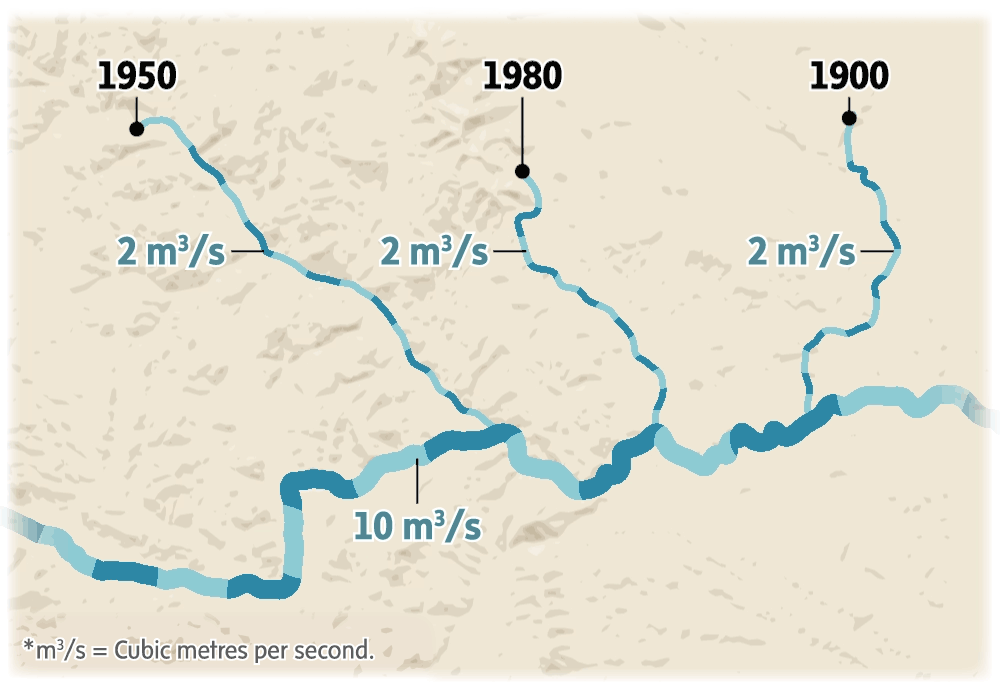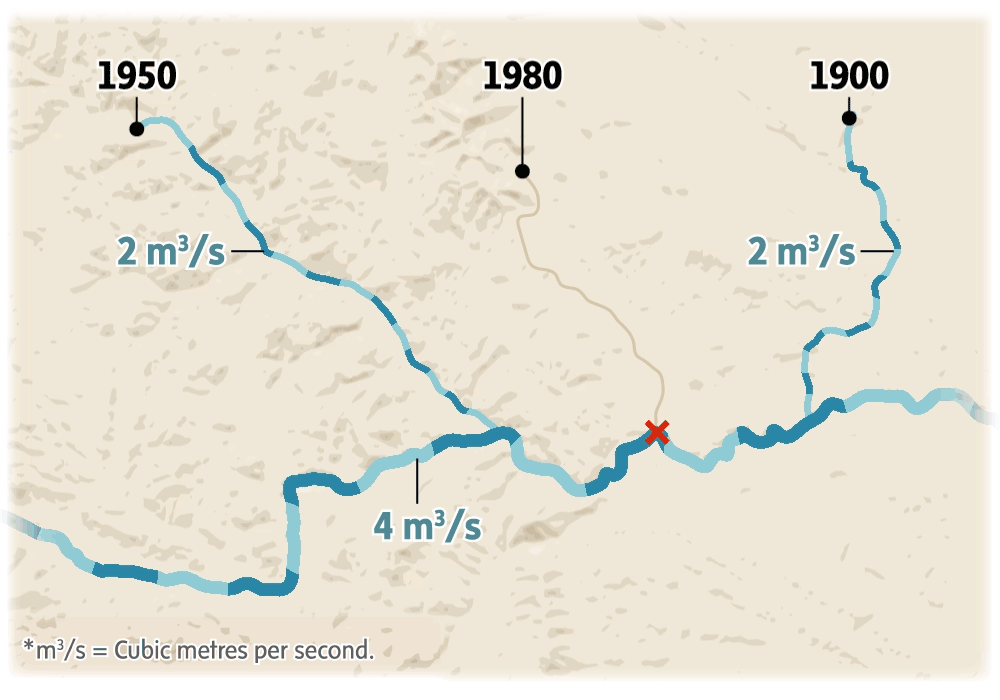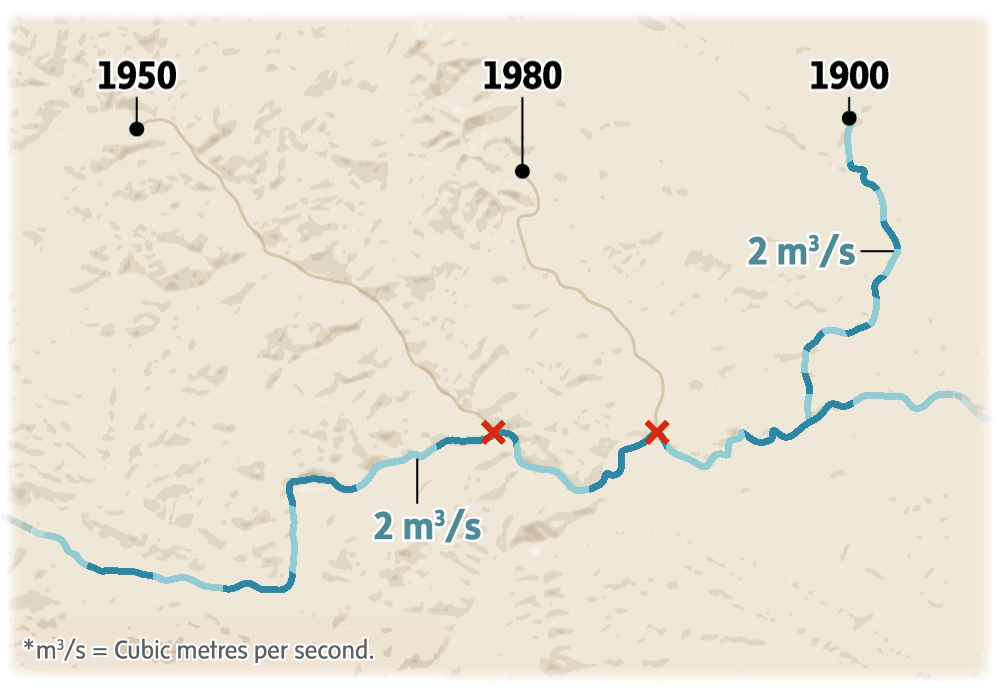Amid a severe drought, negotiations are under way in Alberta that have not occurred for a generation.
The provincial government has convened hundreds of large water consumers in hopes of reaching voluntary agreements to share water in river basins at risk of severe shortages, a move made necessary by a little-understood water-allocation system that originated in the 1800s. The government has described those talks as the most extensive negotiations of their kind in the province’s history.
Though a wet spring might yet bring relief, the Alberta government has decided not to try its luck. This winter, many rivers reached record low levels. As of early March, several reservoirs in Southern Alberta were also far below normal levels for this time of year. One of the most depleted, the St. Mary Reservoir, was at 19 per cent of its capacity, as compared with a normal range of between 49 per cent and 74 per cent.
In the mountains and throughout most of Alberta’s agricultural areas, snowpacks are meagre. Officials are warning farmers that there will be water shortages.
Alberta’s approach to allocating water use is based on a licensing system called “prior appropriation” or “first-in-time, first-in-right” – known as FITFIR. Each licence features a number reflecting when it was issued: the further back in time, the higher its priority. Legally, senior licence holders are entitled to consume their entire water allotment before junior licence holders get a drop. The latter could include municipalities, First Nations, major employers and other important stakeholders, who could find themselves completely cut off.
Even the government acknowledges that FITFIR is a poor way of doling out water during droughts, which have plagued Alberta for as long as people have lived there. And as the climate warms and populations grow, water shortages and disputes could intensify further. Some water law experts suggest it’s time to consider replacing FITFIR with something better suited to 21st-century realities.
Yet this year’s negotiations are just the latest indication that FITFIR works differently in practice than a strictly legal interpretation would suggest. And since water policy is seldom subject to dinnertime debate, the system looks like it’s here to stay – for better or worse.

The negotiations
The 800-pound gorillas of the negotiations are Alberta’s 11 irrigation districts, which primarily deliver water to agricultural producers for crops and livestock. By far the largest licence holders in the province, they’re all at the table with the government, which hired consulting group WaterSmart to help the process along.
Richard Phillips is the general manager of the Bow River Irrigation District, the third largest in the province. An old hand at water management, he has been involved in the sector since the 1980s, so he’s seen firsthand how the process worked during brutal droughts in the 1980s and early 2000s. The last negotiations were initiated by irrigation districts, he said, but this time around the province has taken “the very wise step of getting on top of it” and bringing water licensees to the table before irrigation season begins. “That makes way more sense than scrambling if we do find ourselves in a tough spot this summer,” he said.
Since the talks began in early February, Mr. Phillips said, he has seen nothing but a “tremendous willingness” to reach agreements. The biggest challenge he envisages is the fact those agreements have to happen within the constraints of the Water Act and licence conditions. “It’s not that hard to get a bunch of Canadians to come together and say, ‘We’re in a tough spot, we’ll all share.’ That’s what we do here, right?”

Sharing the shortage
Alberta encompasses seven major river basins, some of which are divided into important sub-basins. The government is hosting water-sharing negotiations this year for the Red Deer, Bow and Oldman sub-basins.
Hay River
Lake
Athabasca
Peace River
Peace
River
Mighty Peace Watershed Alliance
Fort
McMurray
ALBERTA
Athabasca
River
Lesser Slave
Watershed
Council
Lica-Beaver River
Watershed
Athabasca Watershed
Council
Saskatchewan River
Edmonton
Battle River
Watershed Alliance
North Sask.
Watershed
Alliance
Battle
River
Red Deer River
Watershed Alliance
Red Deer River
Calgary
Bow River
Bow River
Basin Council
MAP KEY
Medicine
Hat
Alberta river basins
Oldman Watershed
Council
S.E. Alta.
Watershed
Alliance
Areas with water-sharing
negotiations in progress
Lethbridge
Mild River Watershed Council
Matt Mcclearn and john sopinski/the globe and mail
source: alberta government

Sharing the shortage
Alberta encompasses seven major river basins, some of which are divided into important sub-basins. The government is hosting water-sharing negotiations this year for the Red Deer, Bow and Oldman sub-basins.
Hay River
Lake
Athabasca
Peace River
Peace
River
Mighty Peace Watershed Alliance
Fort
McMurray
ALBERTA
Athabasca
River
Lesser Slave
Watershed
Council
Lica-Beaver River
Watershed
Athabasca Watershed
Council
Saskatchewan River
Edmonton
Battle River
Watershed Alliance
North Sask.
Watershed
Alliance
Battle
River
Red Deer River
Watershed Alliance
Red Deer River
Calgary
Bow River
Bow River
Basin Council
MAP KEY
Medicine
Hat
Alberta river basins
Oldman Watershed
Council
S.E. Alta.
Watershed
Alliance
Areas with water-sharing
negotiations in progress
Lethbridge
Mild River Watershed Council
Matt Mcclearn and john sopinski/the globe and mail
source: alberta government

Sharing the shortage
Alberta encompasses seven major river basins, some of which are divided into important sub-basins. The government is hosting water-sharing negotiations this year for the Red Deer, Bow and Oldman sub-basins.
Hay River
Lake
Athabasca
Peace River
Peace
River
Mighty Peace Watershed Alliance
Fort
McMurray
ALBERTA
Athabasca
River
Lesser Slave
Watershed
Council
Lica-Beaver River
Watershed
Athabasca Watershed
Council
Saskatchewan River
Edmonton
Battle River
Watershed Alliance
North Sask.
Watershed
Alliance
Battle
River
Red Deer River
Watershed Alliance
Red Deer River
Calgary
Bow River
Bow River
Basin Council
MAP KEY
Medicine
Hat
Alberta river basins
Oldman Watershed
Council
S.E. Alta.
Watershed
Alliance
Areas with water-sharing
negotiations in progress
Lethbridge
Mild River Watershed Council
Matt Mcclearn and john sopinski/the globe and mail, source: alberta government
Alex Ostrop, chair of the Alberta Irrigation Districts Association and a farmer near Taber in Southern Alberta, said the current parched conditions are not what farmers want to see as they make decisions about crop rotations during the 2024 planting season. “It’s time to definitely start making some contingency plans,” he said.
Like Mr. Phillips, he said negotiations are going well so far. He thinks the biggest challenge will be ensuring fairness and making certain everyone follows through.
“Once you get into the details of what restrictions might look like, I’m sure there will be some robust negotiations,” he said.
Alberta’s Environment Minister, Rebecca Schulz, said last week that the government has had dozens of conversations about drought with communities across the province since December.
Water-sharing agreements will “make sure that everybody has access to water, and that we’re not seeing industries or municipalities left without,” Ms. Schulz said.
And while negotiations on voluntary sharing agreements are going “extremely well,” she said it’s too early to outline specifics about which water will be conserved and where that water will go.
FITFIR in a nutshell
Free river: no call
Under FITFIR, water licences are prioritized by date of issuance. In this theoretical example, a river contains sufficient water to satisfy the needs of all users – sometimes known as "free river" conditions.

Early season: call begins
But when flows decrease – perhaps as snowmelt tapers off – the river may no longer have enough water to satisfy all users. The senior water right holder (the licence dating to 1900) might place a call, effectively cutting off the most junior licensee (1980).

Late season or drought: full call
Late in the season, or during a drought, river flows can dwindle so much that they can supply only the most senior licence holders, who continue to receive their full allotments while others are cut off.

murat yükselir / the globe and mail
How the system works
Now entrenched throughout western North America, FITFIR originated during a mad scramble for resources: the California Gold Rush. Under long-standing tradition, mineral claims were prioritized chronologically. Since miners needed water to extract gold, that principle was extended to water rights.
By the time Ottawa drew up the Northwest Irrigation Act of 1894, the system of water rights was firmly established throughout the Western United States, and the federal government here embraced it as a model.
Alberta, Saskatchewan and Manitoba adopted FITFIR in their water legislations in 1930, when Ottawa transferred to them the same control over Crown lands and natural resources that other provinces enjoyed.
East of Manitoba, enough precipitation falls to support numerous rivers, streams and lakes. There, the “doctrine of riparianism” (a principle drawn from English common law) prevailed: If a person or business owns land adjacent to a river or lake, they can use that water.
Applying riparianism in the West, though, wasn’t attractive because there’s so much less water available in provinces in the rain shadow of the Rocky Mountains.
Today, Alberta allocates the use of up to 9.5 billion cubic metres of water annually, via 25,000 water licences. A much smaller number – around 350 – will be involved in negotiations because the focus is on those with the largest allocations.
The most recent government data, from 2020, show that irrigation districts have been allocated close to 45 per cent of the water. They also hold some of the oldest water licences. When Alberta’s rivers and streams dwindle, they’re legally in a position to gorge on the remaining trickle while desperate neighbours look on.
That’s the theory, anyway. But David Percy, a professor of law at the University of Alberta, said many of the darkest fears about FITFIR simply haven’t been realized.
“What’s tended to happen in the Western United States, as well as in Canada, is that the FITFIR rule really creates incentives for negotiated solutions,” he said.
There are several reasons why even the most intransigent senior licensees might pause before demanding their whole allotment. The first, Prof. Percy said, is a desire to avoid unwelcome scrutiny of their licences, which may be supported by little more than dusty documents more than a century old.
“If there was litigation, those rights will be looked at under a magnifying glass,” he said. “Do you really have such a big water right as you claim? What’s its legal basis? Was there any uncertainty about the record of the water right?”
Under Alberta’s Water Act, licensees can enter into water-sharing agreements. Gavin Fitch, a lawyer with McLennan Ross in Calgary specializing in environmental law, said some major users – notably irrigation districts and oil sands companies – are closely intertwined with government. The province invested heavily in building out irrigation systems throughout Southern Alberta, for instance, and also strongly supported the oil sands industry.
“There’s just a lot of politics at play here, which is why it’s difficult for senior licence holders to simply insist on their legal rights,” he said.
A grain farmer in Cardston, Alta., checks what is left of his barley crop in 2000, after drought ruined the seeds' value and left it unfit for any use except straw.David Rossiter/The Globe and Mail
A serious drought in 2000 and 2001 prompted Alberta’s last round of negotiations. According to a 2009 paper by two water experts, Stewart Rood and Jenny Vandersteen, those talks began after major irrigation districts sent a letter to Alberta Environment demanding their seniority be enforced.
Given the water available at the time, parties holding licences issued after 1950 stood to receive no water at all. That meant some livestock operations wouldn’t be able to access drinking water. A potato-processing facility near Taber, a large employer and important market for local farmers, also faced cut-off, as did a dozen municipalities.
During the spring of 2001, hundreds of licensees reached an agreement. “Allocations were subsequently established for about 60% of the licensed assignments,” the two experts wrote. For those who opted out, the standard priority rules continued to apply.
Circumstances have forced Albertans to share water resources often enough, Prof. Percy said, that “they recognize that their neighbours have valid uses as well.”
Questions of fairness
Dave Sauchyn, director of the Prairie Adaptation Research Collaborative, has studied centuries of water data across Western Canada drawn from tree rings. He said this year’s drought is consistent with the natural climate variability throughout the region – and far worse droughts have occurred.
But future droughts will happen in a warmer climate. Models suggest those warmer temperatures might actually bring more water to the Prairies, but at different times of the year.
“The downside is that extra water will fall in spring, not in summer when there’s the most demand for water,” he said. “Despite this extra precipitation, you can expect in most years there will be drier conditions in soil and lakes and rivers by mid- to late summer.”
Some believe FITFIR has already outlived its usefulness. One common criticism is that those who fail to use their allotment of water are deemed to have forfeited their licence. When Alberta developed its latest Water Act, it missed a golden opportunity to remove the date-based structure, according to Arlene Kwasniak, a professor emerita of law at the University of Calgary. While it’s not easy to lose a water allocation in Alberta, the act nonetheless fosters a “use it or lose it” mentality, she added.
Jesse Cardinal, executive director of Keepers of the Water, an Indigenous water governance group, said the FITFIR system disregards the inherent water rights of First Nations communities. And she worries that the government and industry view water as something to be commodified, rather than a precious resource.
Ryan Fournier, press secretary for Ms. Schulz, said in an e-mail that multiple First Nations are participating in the water-sharing discussions that are under way and the government has met with various communities as well. Alberta expects the talks to conclude by the end of March.
Nigel Bankes, a professor emeritus of resource law at the University of Calgary, said Alberta should consider a system for water-sharing agreements that would place human and livestock consumption at the top of the chain – for example, by making sure municipalities have enough access to water.
But that would be far more complicated than FITFIR. Prof. Percy said virtually all alternatives would compel governments to determine what water uses are most important, which is a practical and political minefield.
Even so, the Alberta Irrigation Districts Association recently signed an agreement that members would act in “good faith, so that sufficient water can be distributed for human needs and livestock sustenance.”
Critics of FITFIR say there are more humane ways to allocate water when it is badly depleted, as it is now in the Oldman Reservoir.Todd Korol/The Globe and Mail
Mr. Phillips, of the Bow River Irrigation District, acknowledged critiques of FITFIR, but said it has served well as the backbone for water law for more than a century.
“It’s my opinion, it’s widely underrated by those who are opposed to it, and it’s widely overrated by those who like it,” he said.
Mr. Fitch said he doubted the system is on the brink of major reforms.
“For your average Albertan, they don’t know what FITFIR means, and the whole concept of water law and allocations is pretty foreign to most people,” he said.
“I would doubt that there’s going to be any great grassroots rebellion.”
Water and climate change: More from The Globe and Mail
Warmer winters are not just a seasonal problem: A smaller snowpack affects the water that farms and cities depend on year-round. Science reporter Ivan Semeniuk spoke with The Decibel about the latest research of snowpack and its connection to climate change. Subscribe for more episodes.
Meet the young Canadian farmers adapting agriculture to climate change
Rural Nevada bets big on cloud seeding, pitting fears of drought against doubts in the science
Dominican Republic’s cocoa farmers race to adapt to drying jungles